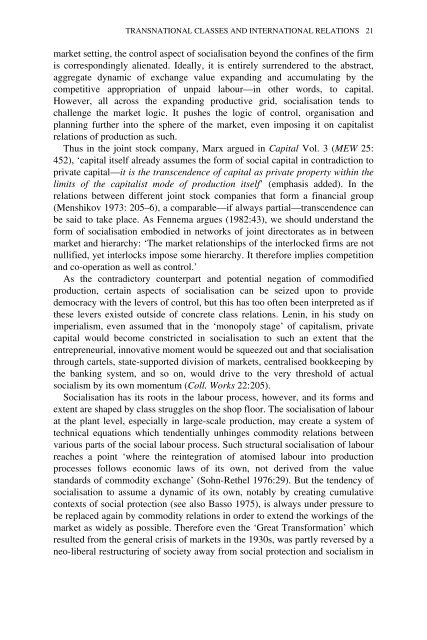van der pijl-transnational classes and IR
van der pijl-transnational classes and IR
van der pijl-transnational classes and IR
- No tags were found...
Create successful ePaper yourself
Turn your PDF publications into a flip-book with our unique Google optimized e-Paper software.
TRANSNATIONAL CLASSES AND INTERNATIONAL RELATIONS 21market setting, the control aspect of socialisation beyond the confines of the firmis correspondingly alienated. Ideally, it is entirely surren<strong>der</strong>ed to the abstract,aggregate dynamic of exchange value exp<strong>and</strong>ing <strong>and</strong> accumulating by thecompetitive appropriation of unpaid labour—in other words, to capital.However, all across the exp<strong>and</strong>ing productive grid, socialisation tends tochallenge the market logic. It pushes the logic of control, organisation <strong>and</strong>planning further into the sphere of the market, even imposing it on capitalistrelations of production as such.Thus in the joint stock company, Marx argued in Capital Vol. 3 (MEW 25:452), ‘capital itself already assumes the form of social capital in contradiction toprivate capital—it is the transcendence of capital as private property within thelimits of the capitalist mode of production itself’ (emphasis added). In therelations between different joint stock companies that form a financial group(Menshikov 1973: 205–6), a comparable—if always partial—transcendence canbe said to take place. As Fennema argues (1982:43), we should un<strong>der</strong>st<strong>and</strong> theform of socialisation embodied in networks of joint directorates as in betweenmarket <strong>and</strong> hierarchy: ‘The market relationships of the interlocked firms are notnullified, yet interlocks impose some hierarchy. It therefore implies competition<strong>and</strong> co-operation as well as control.’As the contradictory counterpart <strong>and</strong> potential negation of commodifiedproduction, certain aspects of socialisation can be seized upon to providedemocracy with the levers of control, but this has too often been interpreted as ifthese levers existed outside of concrete class relations. Lenin, in his study onimperialism, even assumed that in the ‘monopoly stage’ of capitalism, privatecapital would become constricted in socialisation to such an extent that theentrepreneurial, innovative moment would be squeezed out <strong>and</strong> that socialisationthrough cartels, state-supported division of markets, centralised bookkeeping bythe banking system, <strong>and</strong> so on, would drive to the very threshold of actualsocialism by its own momentum (Coll. Works 22:205).Socialisation has its roots in the labour process, however, <strong>and</strong> its forms <strong>and</strong>extent are shaped by class struggles on the shop floor. The socialisation of labourat the plant level, especially in large-scale production, may create a system oftechnical equations which tendentially unhinges commodity relations betweenvarious parts of the social labour process. Such structural socialisation of labourreaches a point ‘where the reintegration of atomised labour into productionprocesses follows economic laws of its own, not <strong>der</strong>ived from the valuest<strong>and</strong>ards of commodity exchange’ (Sohn-Rethel 1976:29). But the tendency ofsocialisation to assume a dynamic of its own, notably by creating cumulativecontexts of social protection (see also Basso 1975), is always un<strong>der</strong> pressure tobe replaced again by commodity relations in or<strong>der</strong> to extend the workings of themarket as widely as possible. Therefore even the ‘Great Transformation’ whichresulted from the general crisis of markets in the 1930s, was partly reversed by aneo-liberal restructuring of society away from social protection <strong>and</strong> socialism in


